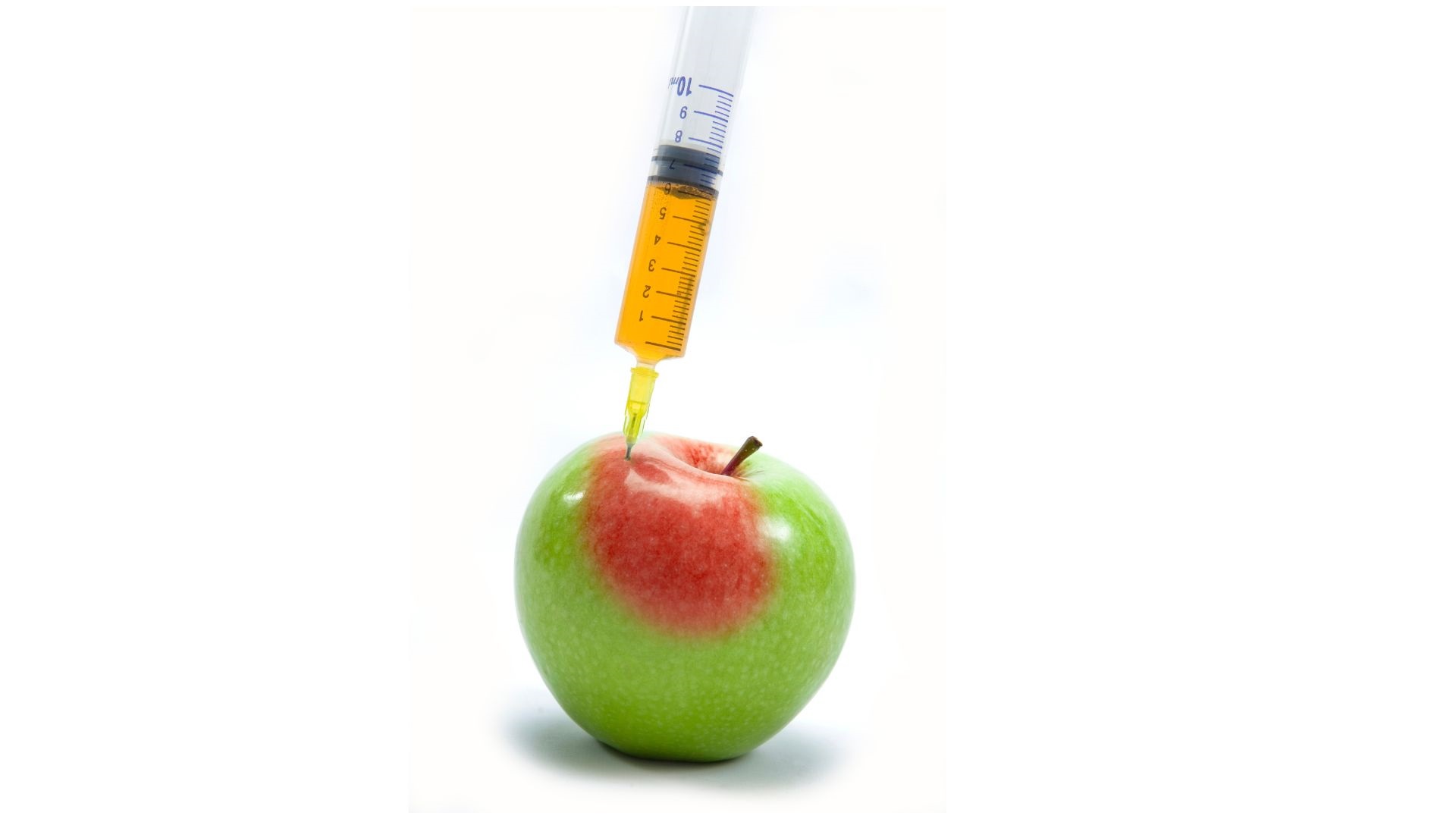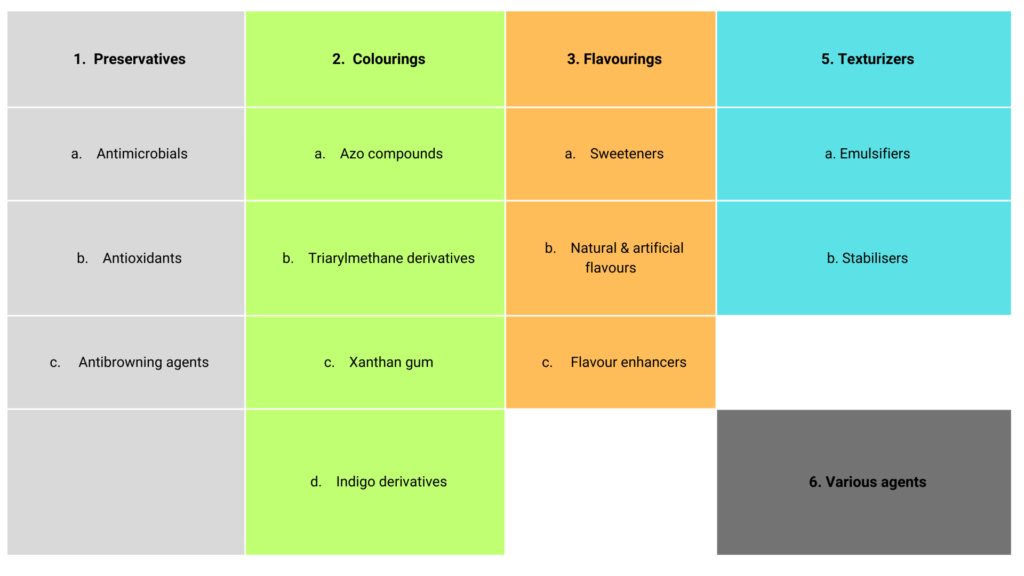
WHY ADDITIVES IN FOOD?
Food additives are substances we do not eat alone but are used to preserve food, enhance it, and prevent undesirable changes during its preparation, classification, processing, packaging, transport, storage, and distribution. In addition to preserving food, they also have other uses (Erkan, 2010; European Commission, 2022), such as:
- extend the shelf-life of foods by preserving their qualities: they preserve, colour and stabilise foods during production, packaging or storage.
- develop sensory properties: give or change the odour or taste of foods.
- prevent health risks.
- reduce food waste.
- increase food diversity.
The types of food additives can be divided into six groups of molecules: preservatives, nutritional additives, colourings, flavourings, texturisers and miscellaneous agents. Below is an outline of the most accurate classification (Carocho et al., 2014). Do any of these look familiar to you?

The image above shows several different types of food additives. You can find more information and make queries for a specific compound and the current legislation by visiting the European Commission for Food Safety website. To find out more in detail, here are the two major databases: that of the European Union and that of the FAO (Codex Alimentarius).
On the other hand, additives used in the EU must have been previously evaluated and used. Therefore, they must have shown being safe in the amounts used, that they are necessary for the foods in which they are authorised and that they do not mislead the consumer.
How can an additive be identified in any food? They must be indicated on the food front-of-package label, either by their common name or by its E-number, the code used by the European Union for additives. For example, when acetic acid is used as an antioxidant, the labelling will show “antioxidant (acetic acid)” or “antioxidant (E 260)” (AESAN, 2022).
Can additives be reviewed? The answer is yes. The European Food Safety Authority (EFSA) is the European Union agency that oversees food safety in the countries of the Union. More specifically, Regulation (EC) No 1333/2008 states in Article 32 that the relevant Commission must set up a programme to re-evaluate the safety of food additives and needs to focus its efforts on those additives permitted before January 2009 (AESAN, 2022).
THE ADDITIVES GUIDE
Els additius alimentaris són tot un món, n’hi ha molts i tenen característiques molt peculiars que són expressades per la seva estructura molecular. Seguidament, et deixem unes claus per tal de saber quins additius duen els aliments que pretens comprar (Organització de Consumidors I Usuaris, 2020). En color verd s’indiquen els que el seu consum no és tan perillós i són necessaris per a mantenir l’estat adequat de l’aliment; mentre que en taronja corresponen a aquells que poden consumir-se en poques quantitats i, en vermell, els que cal evitar. Recorda, però que el millor aliment és aquell fresc, no processat i que, per tant, no necessita pas additius per a conservar-se. A més, tot additiu té unes dosis màximes de consum i certs riscs associats.
Food additives are a whole world. There are many of them, and all have peculiar characteristics defined by their molecular structure. Here are some tips on how to find the additives in the food you intend to buy (Organización de Consumidores y Usuarios, 2020). The green colour indicates those additives whose consumption is not dangerous and are necessary to maintain the proper state of the food. Orange indicates those additives to be consumed in small quantities, while red identifies those better avoided. Remember, however, that the best food is fresh, unprocessed food that does not need additives for preservation. In addition, all additives have maximum doses of consumption and certain associated risks.

We will now discuss colours, which are a controversial component in the food industry.
COLOURS
As mentioned above, food colours are substances used to alter or impart colours to foods to increase their attractiveness to consumers. These compounds have been the subject of many different studies, one of the most controversial being The Southampton Study. The study differentiated two groups of children: one group ate their food with harmless substances (placebo), and the other had a cocktail of food colourings added.
However, there was evidence that children who consumed the dyes developed attention deficit hyperactivity disorder. Authorities, such as the EFSA, strongly contested the study, but public advocacy groups and the media promoted a voluntary ban on the colours. A couple of years later, a follow-up study on food additives in Irish children noted that compared to the Southampton study, children would never be exposed to such high doses of additives, which is why food dyes were accepted again.
The truth is that there are contradictory results for virtually all food colours. It is very worrying, especially as few studies have considered the interactions of colours with health decline. The situation needs to be regularised, and the consumer community needs to be adequately informed about this issue (Carocho et al., 2014).
ARE NATURAL ADDITIVE BETTER THAN ARTIFICIAL ONES?
Today, society is more aware and interested in what it eats. It is why natural additives have been gaining interest from both food industries and consumers. Some studies show that consumers prefer foods prepared with natural rather than chemical additives for health reasons.
Natural additives are quite promising, but present some drawbacks and limitations:
- One of them, for example, is the difficulty in finding sources of the plants or microorganisms that produce these substances, causing overharvesting in some cases that can damage the ecosystems where they belong.
- The benefits of natural additives are infinite, their synergy and potency are a significant leap from synthetic ones, and they are usually safer than the latter. Yet, we must never overlook their potential toxicity, so they must pass toxicological, carcinogenic and other safety studies to ensure safety and avoid scares.
- Another problem is precisely the synergistic effects of additives and the possibility of using them for several purposes. It may be a good thing, but it also causes some additives not to be compatible with other additives or some ingredients in the same food, in which case they cannot be used.
Despite these limitations, natural food additives are the future of food preservation because of their health benefits and synergies. Once their limitations are addressed, they will gain even more interest. Lately, the market has been promoting consuming food with additives, and new products display labels such as “all-natural additives” or “no synthetic additives” (Carocho et al., 2014).

